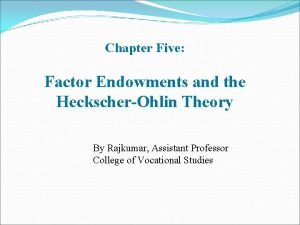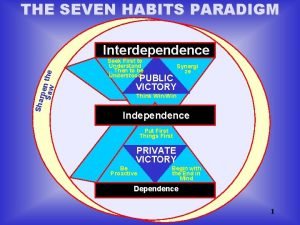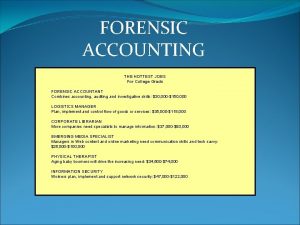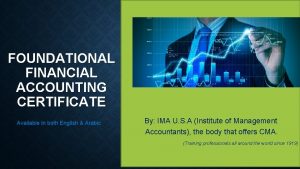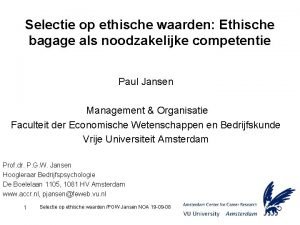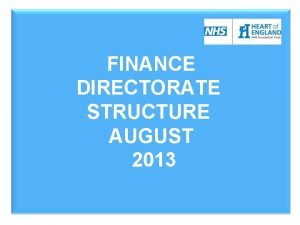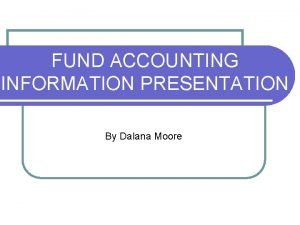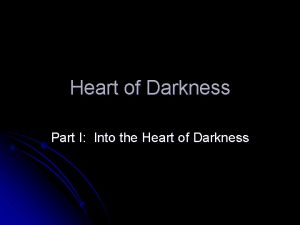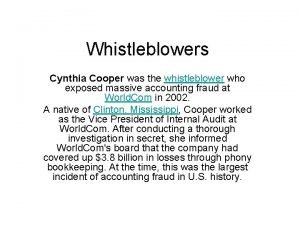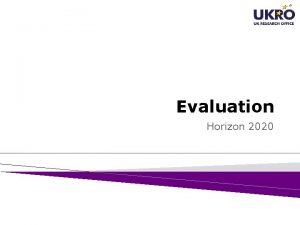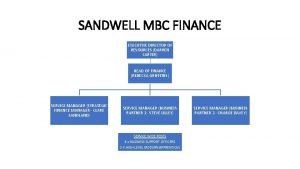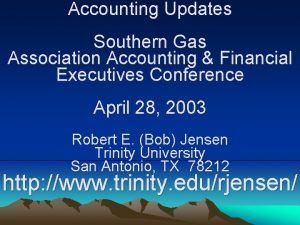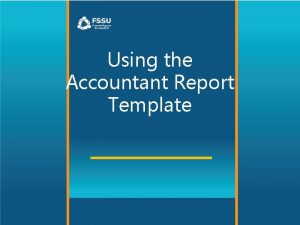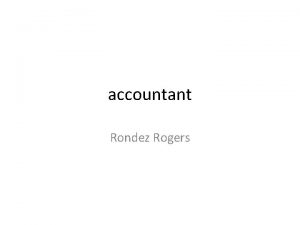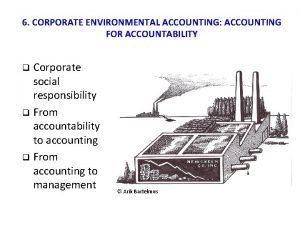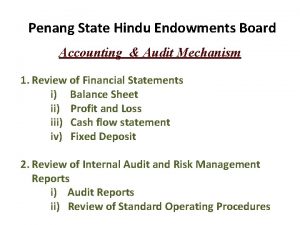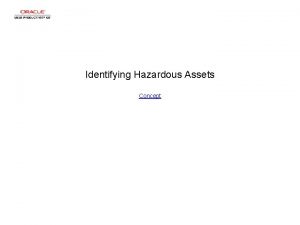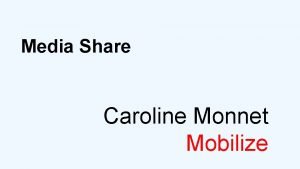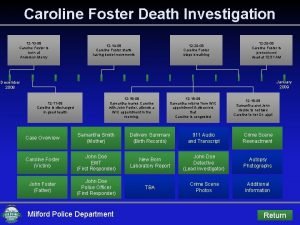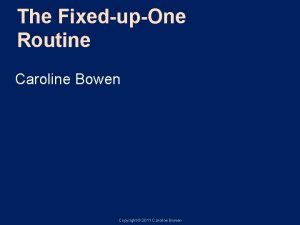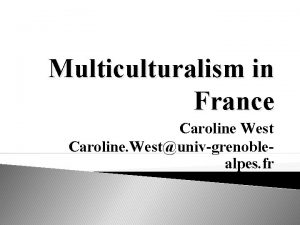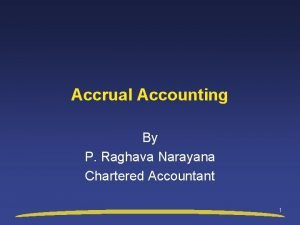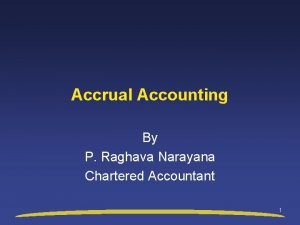Accounting for Endowments Caroline Wilson Corporate Accountant Identifying












































- Slides: 44

Accounting for Endowments Caroline Wilson Corporate Accountant

Identifying an Endowment An endowment is a type of gift.

Identifying an Endowment The SORP description for this is a non-exchange transaction: 18. 1 - ‘. . . those transactions whereby an entity receives (or gives) value from / to another entity without directly giving / receiving approximately equal value in exchange. ’ Ross-CASE definition of philanthropic intent Endowments should meet the Ross-CASE definition of philanthropic intent: ‘all giving which does not confer full or partial ownership of a deliverable, financial benefit, or control to the funder in return for the funding. The gift must be owned in full by the receiving institution once it is received. ’

Identifying an Endowment Fundamentally, there are two different types of gift: • Donation • Endowment

Identifying an Endowment The difference between the two is: • Donation – the money is given to be spent • Endowment – the money is given to be invested

Identifying an Endowment It is like the difference between giving someone a chicken (endowment)… …and an egg (donation).

Identifying an Endowment An endowment is said to exist if it is the donor’s intention is for the University to establish an endowment fund, and to invest the money. From this investment the University receives dividend income, which can then be spent.

Identifying an Endowment An endowment can be divided into three elements: Capital Growth Capital – (i. e. the original gift amount) Dividend Income

Classifying an endowment Once a gift has been identified as an endowment, the correct classification needs to be decided: • Permanent – Unrestricted • Permanent – Restricted • Expendable – Restricted Unrestricted Permanent Donation Restricted Permanent Restricted Expendable

Classifying an endowment DDAR are responsible for classifying gifts. They do this based on discussions with the donor and using the ‘Donations and Endowments – Decision Tree’. If you are aware of a potential gift, please inform DDAR. All gifts should be received via the RBS Gift Bank Account. Gifts that are more than £ 50, 000 are sent to the HOFF to review. The HOFF confirms whether the gift, and its proposed classification, fits with the Faculty’s operational strategy. Management Accounts review whether the gift classification is the correct treatment.

Classifying an endowment To correctly classify the endowment, you need to answer two questions.

Classifying an endowment Question 1: Does the donor specify how long the money needs to be invested for? – i. e. are we ever allowed to spend the capital?

Classifying an endowment Possible answers: • In Perpetuity – i. e. Forever • Not forever – time period specified • Not forever – time period not specified

Classifying an endowment • If forever– PERMANENT • If not forever – EXPENDABLE

Classifying an endowment Question 2: Does the donor specify what the money is to be used for?

Classifying an endowment Possible answers: • Yes – RESTRICTED • No - UNRESTRICTED

Classifying an endowment The word ‘restriction’, needs to be approached with caution. When communicating about endowments, the word ‘restriction’ is used in two different contexts.

Classifying an endowment Context 1: Classification– i. e. the restriction in use Context 2: Accounting Treatment – endowment capital, capital growth and unspent endowment dividend income are held separately in restricted endowment reserves

Classifying an endowment Also… The definition of ‘restrictions’ used in the context of donations cannot be applied to endowments. In creating an endowment, the donor places a legally-binding obligation on the University to set up a charitable trust. This means that any requirement(s) specified by the donor are legally-binding, and therefore under trust law are deemed to be restriction(s), unless it is the donor’s intention that the income is used for general purposes.

Classifying an endowment De-Minimis Thresholds • There is a de minimis threshold of £ 100, 000 for setting up a permanent endowment • it will be permissible for a donor to set up a restricted expendable endowment of a capital value less than £ 100, 000; however, • any proposed restricted expendable endowments less than £ 100, 000 must be approved by Finance Sub Committee DDAR will discourage donors from setting up restricted expendable endowments of a capital value less than £ 50, 000, unless there is a strategic reason for doing otherwise. Where possible DDAR will encourage donors to add to the new endowment funds being created as a result of the restructure of the pre-2004 endowments.

1. Please see Appendix A of ‘Donations and Endowments De Minimis Threshold’ paper for definitions of these terms (when used in the context of donations and endowments). 2. An endowment is a form of charitable trust, which is created if a donor expresses their intention for the gift to be used to establish an endowment fund. 3. Entitlement is considered to be on receipt, except for legacy donations, when entitlement is considered to be once probate has been granted, the gift purpose agreed, and the gift agreement process completed. 4. If a gift to establish a restricted permanent endowment of less than £ 100, 000 is offered, DDAR will liaise with the donor or executors wherever possible to agree an alternative gift model. 5. It is expected that donations with performance-related conditions will be rare. Please see Appendix A of ‘Donations and Endowments De Minimis Threshold’ paper. 6. Any proposed restricted expendable endowments less than £ 100, 000 must be approved by Finance Sub Committee.

Scenarios 1) A donor makes a gift of £ 500, 000, the income only from which is to be used for the general purposes of the Biology department. 2) David Brown gives £ 1, 500, 000 to endow a chair in English in perpetuity. 3) Prof Monica Williams leaves the residue of her estate (£ 200, 000) to “endow postgraduate scholarships in music”. The Will states that “the University shall be at liberty to expend not only the income but also the capital in providing the award”. 4) Prof B Fox gives £ 50, 000 to “provide, (in the event of a total solar eclipse), solar eclipse glasses to music students who specialise in drumming”.

Scenarios 1) A donor makes a gift of £ 500, 000, the income only from which is to be used for the general purposes of the Biology department. • Intent to endow in perpetuity – “income only”, can’t spend capital • To be used for “general purposes” (no restriction) Unrestricted Permanent

Scenarios 2) David Brown gives £ 1, 500, 000 to endow a chair in English in perpetuity. • Intent to endow in perpetuity • To be used to endow a chair in English (restriction) Restricted Permanent

Scenarios 3) Prof Monica Williams leaves the residue of her estate (£ 200, 000) to “endow postgraduate scholarships in music”. The Will states that “the University shall be at liberty to expend not only the income but also the capital in providing the award”. • Intent to endow, but not in perpetuity • To be used to endow postgraduate scholarships in music (restriction) Restricted Expendable

Scenarios 4) Prof B Fox gives £ 50, 000 to “provide, (in the event of a total solar eclipse), solar eclipse glasses to music students who specialise in drumming”. • No intent to endow • But restrictions are so specific that it is likely that the donation will not be able to be spent in less than 5 years. Restricted Expendable

Accounting for Endowments 2015 SORP How is accounting for endowments different?

Accounting for Endowments The 2015 SORP introduces the concept of restricted endowment reserves. At year end, a transfer will be made of dividend income and expenditure relating to restricted endowments (both permanent and expendable), from unrestricted reserves to the correct restricted endowment reserve. The balance on these reserves will equal the remaining unspent income. This transfer will be performed by Management Accounts In the Annual Report, there is effectively no change in the required disclosure of endowment funds, other than being renamed ‘Endowment Reserves’.

Accounting for Endowments Under the 2015 SORP: • New endowments will be recognised as income in the Statement of Comprehensive Income (SOCI) • Capital appreciation / depreciation (on endowments invested) will be recognised as a gain or loss in the SOCI under the gain/loss on investments This will introduce VOLATILITY

Accounting for Endowments Therefore, new endowments and capital appreciation / depreciation will be recorded centrally. This minimises the impact on School accounts. These transactions will be recorded by Management Accounts

Accounting for Endowments No SORP Adjustment - Income and expenditure will no longer be matched in School accounts

Accounting for Endowments 2015 SORP How is accounting for endowments the same?

Accounting for Endowments • Dividend income will still be recorded in School accounts on individual WK activity codes – by Management Accounts • Expenditure will still be recorded in School accounts on individual WK activity codes – by School But these will no longer be matched

Summary of Accounting Treatment Unrestricted Permanent New Capital Release Dividend Income to Unrestricted Reserves Capital Appreciation / Depreciation Statement Responsibility SOCI - (Central) Management Accounts Drops through to balance sheet (reserves) Management Accounts SOCI - (In School) Management Accounts SOCI - (In School) School Transfer capital from Unrestricted Reserves to Permanent Unrestricted Permanent Restricted Expendable Endowment (Capital) Reserve Dividend Income Expenditure Restricted Expendable Recognise immediately in Donations and Endowments Income Restricted Permanent Hold Dividend Income in temporarily restricted reserves until spent Charged to relevant WK code Capital appreciation/depreciation recognised in SOCI and released to Permanent Unrestricted Endowment (Market Value adjustment) Reserve Capital appreciation/depreciation recognised in SOCI and released to Permanent Restricted Endowment (Market Value adjustment) Reserve Capital appreciation/depreciation SOCI - (Central) recognised in SOCI and released to Restricted Then drops through to Expendable Endowment balance sheet (Market Value adjustment) (reserves) Reserve Management Accounts

New – Endowment IE Codes Statement IE Code New Endowments SOCI Market Value Adj. SOCI Dividend Income SOCI 1910 1911 1912 1913 1914 1915 1916 1917 1918 Description New Permanent Restricted Endowments Received New Permanent Unrestricted Endowments Received New Restricted Expendable Endowments Received Permanent Restricted Endowments - Market Value Adjustment Permanent Unrestricted Endowments - Market Value Adjustment Restricted Expendable Endowments - Market Value Adjustment Income from Restricted Permanent Endowments Income from Unrestricted Permanent Endowments Income from Restricted expendable Endowments From 1 st August 2015, IE Codes 1901 (dividend income) and 1907 (SORP adjustment) will no longer be in use.

New – Endowment IE Codes Statement Investments Balance Sheet Restricted Permanent Balance Sheet Unrestricted Permanent Balance Sheet IE Description Code 9070 University Investments Cost 9904 Transfer to Permanent Restricted Endowment Reserve in respect of Capital 9905 Transfer to Permanent Restricted Endowment Reserve in respect of Market Value Adjustment 9906 Unspent Accumulated Income on Permanent Restricted Endowments 9924 Transfer to Permanent Unrestricted Endowment Reserve in respect of Capital Transfer to Permanent Unrestricted Endowment Reserve in respect of Market Value Adjustment Transfer to Restricted Expendable Endowment Reserve in respect of Capital Transfer to Restricted Expendable Endowment Reserve in respect of Market Value Adjustment Unspent Accumulated Income on Restricted Expendable Endowments Transfer to Endowment Reserve in respect of New Endowment Capital Transfer to Endowment Reserve in respect of Market Value Adjustment Transfer of Unspent Income to Restricted Endowment Reserves 9925 Restricted Expendable Balance Sheet 9944 Balance Sheet 9945 Balance Sheet Unrestricted Reserves Balance Sheet 9946 9984 9985 9986 From 1 st August 2015, IE Codes 9700, 9701, 9702, 9703, 9704, 9705, 9706, 9707, 9708, 9709, 9710, 9712 and IE Codes 9200, 9201, 9206, 9312 will no longer be in use.

Oracle From the 1 st August 2015, endowment data will become more accessible to Schools and Faculties via Oracle. The data that will become newly accessible is: • Number of units in the Common Investment Fund • Date of inception • Restriction(s) on use • Disclosure category – e. g. chair, fellowship, scholarship etc. To access the data run ‘ 403 GL Activity Codes Setup Detail’ report on the relevant WK activity code(s).

Management Accounts

Reclassification under 2015 SORP Under the 2007 SORP, there were no such concepts as: • a ‘restricted donation’ • a ‘donation with performance-related conditions’ A gift could only be classified as a donation if it was deemed that there were no restrictions on how the gift could be spent. Therefore, under the 2007 SORP, if the donor made a restricted gift, even if there was no donor intent to create an endowment then, per the 2007 decision tree, it would have to be classified as restricted expendable endowment.

Reclassification under 2015 SORP The 2015 SORP introduces the concepts of a ‘restricted donation’ and a ‘donation with performance-related conditions’. The 2015 SORP also introduces the requirement for a donor to explicitly express their intent for an endowment fund to be established. Therefore, any restricted gifts with no donor intent to create an endowment fund that were classified as ‘restricted expendable endowments’ under the 2007 SORP, will now need to be reclassified as a type of donation under the 2015 SORP.

Reclassification under 2015 SORP A review has been performed of all post-2004 endowments, to identify any which require reclassification as a donation. Once audit work is complete, any endowments that are to be reclassified will be communicated to the relevant Schools via the HOFFRA. If there is a requirement to track the donation, it can be held on an 8999 code.

Endowment Project The University are currently restructuring the endowment portfolio. In 2015/16 further changes will be made to how we account for endowments. Once the restructure is complete - these changes will be communicated, and further training provided.

Contacts Endowment and Donation Leads EPS – Nicola Cosens FLS - Sasha Windelinckx Hums - Catherine Harrop (Endowments), Philippa Woods (Donations) MHS - Gemma Mossop

Questions
 Heckscher ohlin theory
Heckscher ohlin theory The seven habits paradigm
The seven habits paradigm Selling endowments
Selling endowments Caroline wilson tips
Caroline wilson tips Non identifying adjective clauses examples
Non identifying adjective clauses examples Information essential
Information essential Identifying and non identifying adjective clauses
Identifying and non identifying adjective clauses Famous forensic accounting cases
Famous forensic accounting cases Certified management accountant
Certified management accountant Estonia accountant
Estonia accountant Ethisch dilemma accountant voorbeeld
Ethisch dilemma accountant voorbeeld Junior accountant career path
Junior accountant career path Strategic accountant
Strategic accountant Fund accounting
Fund accounting Estonia accountant
Estonia accountant Lcmha
Lcmha Chief accountant heart of darkness
Chief accountant heart of darkness Cynthia cooper (accountant)
Cynthia cooper (accountant) Ian devine accountant
Ian devine accountant Role and responsibility of management accountant ppt
Role and responsibility of management accountant ppt Strategic accountant
Strategic accountant Cynthia cooper (accountant)
Cynthia cooper (accountant) Term and reversion valuation
Term and reversion valuation Objective of corporate finance
Objective of corporate finance Debntures
Debntures Ro i rom pax
Ro i rom pax Byggprocessen steg för steg
Byggprocessen steg för steg Vätsketryck formel
Vätsketryck formel Densitet vatten
Densitet vatten Elektronik för barn
Elektronik för barn Läkarutlåtande för livränta
Läkarutlåtande för livränta Shivaismen
Shivaismen Tack för att ni har lyssnat
Tack för att ni har lyssnat Inköpsprocessen steg för steg
Inköpsprocessen steg för steg Smärtskolan kunskap för livet
Smärtskolan kunskap för livet Mjälthilus
Mjälthilus Delegerande ledarstil
Delegerande ledarstil Toppslätskivling dos
Toppslätskivling dos Returpilarna
Returpilarna Särskild löneskatt för pensionskostnader
Särskild löneskatt för pensionskostnader Borra hål för knoppar
Borra hål för knoppar Myndigheten för delaktighet
Myndigheten för delaktighet Redogör för vad psykologi är
Redogör för vad psykologi är Tack för att ni lyssnade
Tack för att ni lyssnade Mat för idrottare
Mat för idrottare
